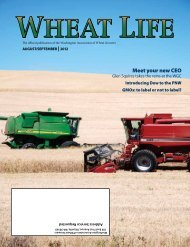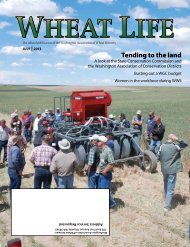Download - Wheat Life
Download - Wheat Life
Download - Wheat Life
You also want an ePaper? Increase the reach of your titles
YUMPU automatically turns print PDFs into web optimized ePapers that Google loves.
WGC REPORTS WL<br />
Not so fast<br />
Man’s CLIMATE CHANGE IMPACT quESTIONED<br />
It’s not that wheat farmers are skeptical of global warming and the potential for<br />
climate change, it’s that many of them believe man’s impact on the environment is<br />
puny compared to the planet’s self-regulating mechanisms. Art Douglas couldn’t<br />
agree more.<br />
Professor emeritus at Creighton University in Nebraska where he taught for 25 years,<br />
Douglas now lives in Arizona where he continues to consult. Although most mainstream<br />
scientists agree climate change caused by humankind’s CO2 contribution to the<br />
atmosphere is occurring, Douglas begs to differ. Not only that, he questions whether<br />
rising CO2 levels are necessarily a bad thing, especially when viewed against a historical<br />
record of ice cores that reveal levels 15 to 20 times higher during various prehistoric<br />
periods.<br />
“Don’t let anyone tell you CO2 is a bad for you and is going to kill us. It’s always been<br />
much higher than it is now,” he said, adding the earth has also tended to be warmer<br />
than it is now.<br />
Douglas calls on the work of Milutin Milankovic, a Serbian geophysicist and<br />
civil engineer who lived from 1879 to 1958, to back up his contention that man has<br />
very little to do with the changing climate. While interned in Hungary during the First<br />
World War, Milankovic worked out a theory on the occurrence of ice ages based on periodic changes in earth’s orbit in<br />
relation to the sun and the tilt of its axis.<br />
In a nutshell, the change in the tilt of the Earth’s axis and the placement of the earth in an elliptical orbit which sometimes<br />
takes it further from the sun creates a 100,000-year climate cycle. Although Milankovic’s work was just a theory<br />
during his lifetime, deep sea core samples have proven a cycle of rapid warm ups of the planet followed by a slow cooling<br />
down with a corresponding rise and fall in CO2.<br />
Showing a graph of the rhythm of warming and cooling over 400,000 years, Douglas asked, “Where are we now A<br />
rapid rise in temperature. Humans who are so worried about what we are doing with CO2 have got to realize we are<br />
in a Milankovic cycle that is at the peak of<br />
Sun spot numbers and<br />
global sea surface temperatures<br />
warming.”<br />
Another aspect of climate change unrelated<br />
to Milankovic’s work looks at sunspots.<br />
Douglas said there is a relationship<br />
between sunspots and the temperature of<br />
the Pacific and Atlantic oceans.<br />
“What is controlling our climate The<br />
Atlantic and the Pacific. What is causing the<br />
oceans to warm up and cool off Sunspots.<br />
We are seeing a natural phenomenon.<br />
There’s a lot more to the story than what<br />
is being told to you,” he said. “Should we<br />
be worried about CO2 in the atmosphere<br />
No, because it is not going to be there much<br />
longer.”<br />
WASHINGTON GRAIN COMMISSION<br />
Slide taken from Art Douglas’ presentation at the 2011 Tri-State <strong>Wheat</strong> Convention<br />
WHEAT LIFE JANUARY 2012 49










